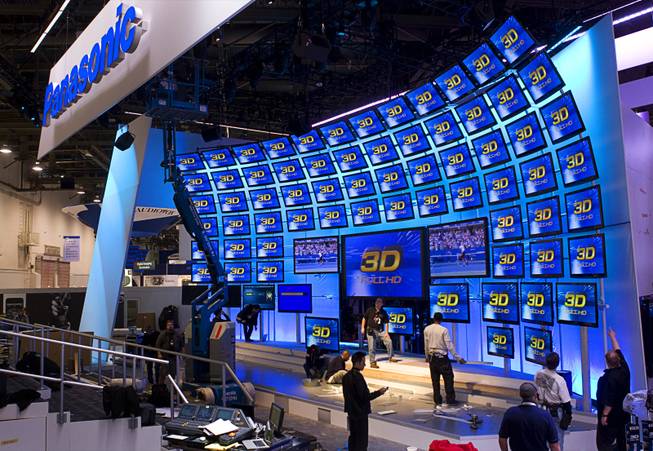
Workers in the Panasonic booth prepare Wednesday for the 2011 International Consumer Electronics Show.
Friday, Jan. 7, 2011 | 4:20 p.m.
CES: Timelapse Tour of Technology
Get an inside look at the biggest technology convention in the world, the Consumer Electronics Show.
Beyond the Sun
Smart phones, tablet computers and Internet-enabled televisions are some of the buzz-worthy items at this year’s International Consumer Electronics Show in line to have a major effect on society as technologies associated with them improve and become more widely adopted.
That’s according to five electronics industry experts who offered their views on disruptive technologies as part of a panel discussion led by Tim Bajarin, president of technology-research firm Creative Strategies and columnist for PC Magazine.
“I think we’ll look back in five years and we’ll see that a significant part of the world’s population did their first computing on a smart phone or on a tablet,” said Mike Rayfield, general manager for mobile business for NVIDIA.
He said devices like tablets and smart phones augment traditional computers because they are devices used on-the-go.
“These are really supercomputers in your pocket,” he said.
The devices also have changed the way people interact with computers because they transcend generations, he said. This is especially true with tablets.
He cited an example in which a group of senior citizens, unwilling to use a traditional computer, were given an Apple iPad.
It was a hit, he said.
“(Tablets) are going to change the usability powers of how people connect,” he said. Because they use the same sorts of technology, tablets will “grab onto the explosive growth of superphones and they’ll sort of rise together,” he said.
Ted Theocheung, vice president of the PC and Digital Home Division of Synaptics, pointed to the increasing adoption of touch technology.
“Touch has really become pervasive because it’s natural … it’s intuitive, it’s easy to use,” he said.
Notebook computers started using touch with the trackpad. Now many smart phones have touch screens, as do tablets.
Touch technology is progressing to the point where it’s starting to be used for television remote controls, he said.
As the technology improves, it will increasingly reduce the need for a keyboard on many devices, he said.
But it’s not just the devices themselves that are changing consumer behaviors: The network that powers them is key.
Mel Coker, AT&T’s vice president of product development and operations for emerging devices, said her company is focusing on “ubiquitous connectivity,” or the concept of devices always being on and always being connected to the mobile broadband network.
She said her company envisions being able to wirelessly connect “anything with a current” of electricity running through it.
“A lot of people think about it just as the network. But it really takes a combination of the network, devices and applications to bring it all to life,” she said. “The one thing that really drives adoption … is you’ve got to have a simple, seamless customer experience.”
Coker cited some statistics: By the end of 2011, half of all handsets will be smart phones. Apps for smart phones “have just exploded,” she said. In 2009, 800 million were downloaded – a figure that’s projected to rise to 25 billion by the end of this year.
Upgrades to non-portable devices – especially televisions with Internet connectivity and TVs that support 3-D technology – will significantly alter the way consumers interact with devices, said Levy Gerzberg, president and CEO of the Zoran Corporation, which makes chips for consumer electronics.
For Gerzberg, the most exciting item at CES and in the past few years has been so-called smart TVs that can connect to the Internet.
“I think it will change our lives in the living room, no doubt about it,” he said, adding that he foresees significant changes in how advertisers reach consumers.
“I believe the connected TV will be disruptive not only in our behavior, it will disrupt the way advertising is happening,” he said. Changes in how advertisers connect with consumers means additional opportunities for revenue and the ability of startups to enter into untapped markets.
That said, connectivity is just one way in which television sets are advancing. At the 2010 CES, 3-D TVs were the talk of the show and in the past year, the technology has become increasingly pervasive, said Josh Greer, president of 3-D technology company RealID.
In the next few years, Greer said, most new televisions will be manufactured to be capable of emitting a signal that can be used with a universal set of 3-D glasses. Eventually, he’d like to see 3-D be possible without the use of glasses; however, the technology is complex and doing away with the special spectacles would be quite a ways down the road, he said.
Taking into account how the “visual experience” has evolved over the past 100 years, Greer said his company views 3-D “as the next logical step.”
“To us, it’s just kind of a natural add-on,” he said.

Join the Discussion:
Check this out for a full explanation of our conversion to the LiveFyre commenting system and instructions on how to sign up for an account.
Full comments policy